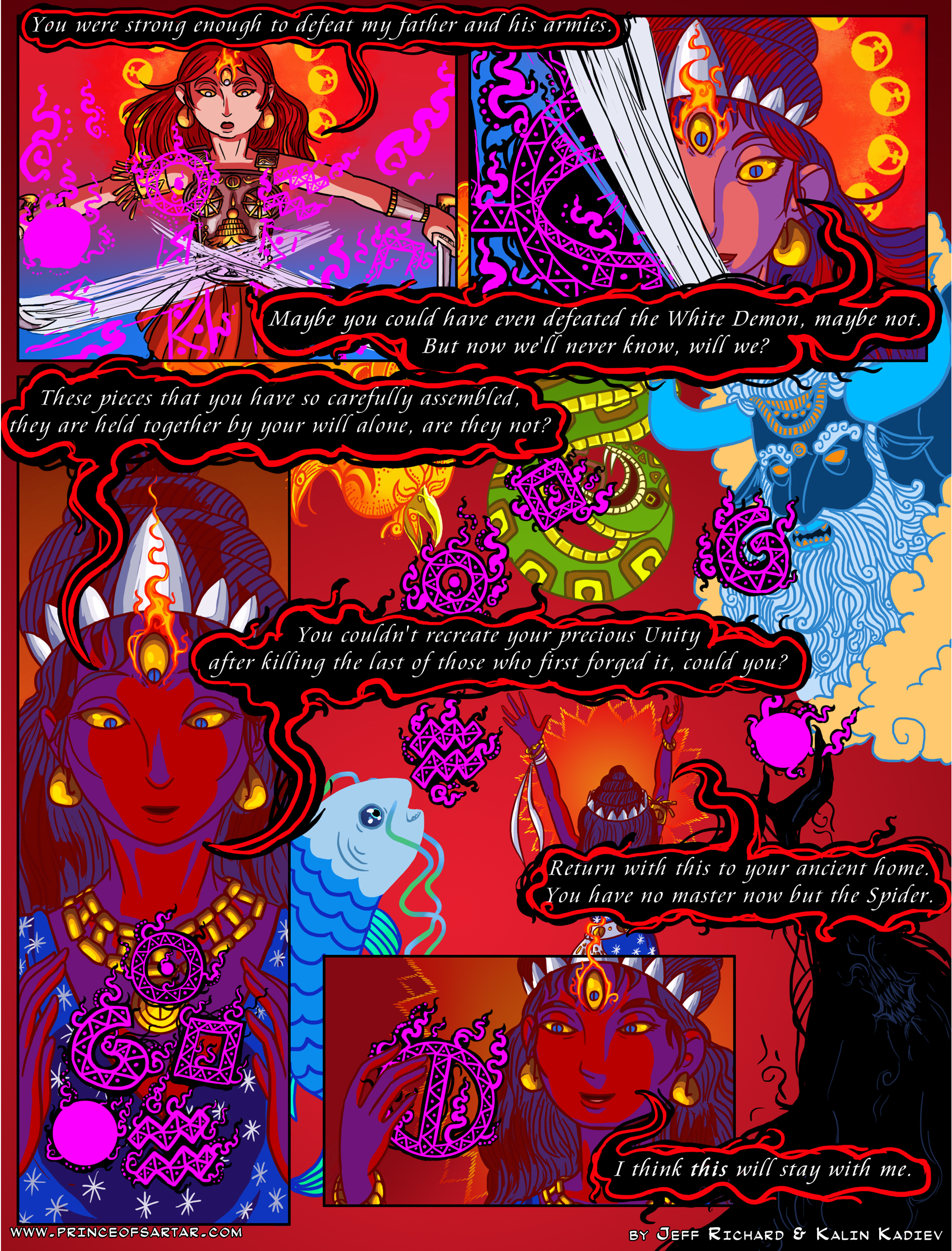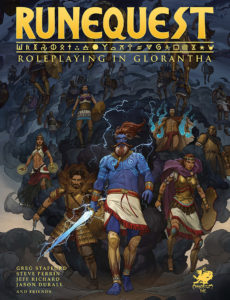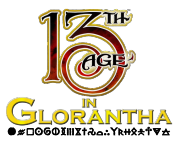Prince of Sartar
How one man became a god
There are currently no widgets assigned to the left-sidebar, place some!
Once you add widgets to this sidebar, this default information will go away.
Widgets can be added by going to your dashboard (wp-admin) ➔ Appearance ➔ Widgets, drag a widget you want to see into one of the appropriate sidebars.
Once you add widgets to this sidebar, this default information will go away.
Widgets can be added by going to your dashboard (wp-admin) ➔ Appearance ➔ Widgets, drag a widget you want to see into one of the appropriate sidebars.
Languages
Prince of Sartar is an epic story of the Hero Wars set in Greg Stafford's Glorantha.
By Jeff Richard and Kalin Kadiev.
Curious about Glorantha?
Chapters
Recent Comments
- jaguar on 119 – Time to rest
- Colie Dillon on 119 – Time to rest
- Steve S. on 119 – Time to rest
- Oliver Dickinson on 119 – Time to rest
- greattsathoggua on 119 – Time to rest







When Jar-Eel says Belintar killed “the last of those who first forged… your precious Unity,” does she mean the Only Old One? Was Belintar’s work somehow linked to the legacy of the old Unity Council?
And why is Holy Country’s sorcerous sixth represented by a Moon Rune instead of a Law Rune? I mean, it’s convenient for the Razoress. I get that. But is there any *other* reason the Holy Country’s God Forgot (Brithini Talar) sixth would have been denoted by a Moon Rune instead of a Law Rune? Did the Moon Rune have sorcery or Brithini associations before the Red Goddess arose?
Seehttps://plus.google.com/101223324205853115305/posts/Y99dVsCUXTf for a possible/likely explanation for the Moon Rune in Belintar’s Holy Country.
According to my copy of Guide to Glorantha the Lunar Rune is also the Rune of Balance. God Forgot then holds the nations of the five elements in balance.
What was the Rune Rufelza keeps in her hands doing in Belinthar’s circle??
I’m loving the red vibe in this piece, contrasting nicely with the other colours. Another great job, Kalin.
It has replaced the air/storm rune.
It looks like the Moon.
Just wondering, did Belintar become Harshax in the future? I was always confused about that.
Great page, though her face seems a bit off. Keep up the good work
And who did Belintar kill as the last of his original helpers? I’m no expert in Holy Country history
So Lunar Heroes, like Jar Eel, can enter other’s rituals via the connection they stole by defeating certain deities or temples or peoples and inside the ritual they can channel a powerful deity so that She changes the ritual from within? Awesome power, indeed. It looks Unfairest to other Heroes, like Belintar or Sartar (or Kallyr). Almost a Chaotic power, they would think
Jar-eel severs the Unity of the Sixths, explaining why they fall into disorder so rapidly (aside, of course, from the fact that Belintar isn’t coming back). And she takes the Moon rune with her. The Lunars don’t seem to pay much attention to God Forgot when they move on the Holy Country. I think this is because the Red Goddess already owns the Lunar sovereignty of the area through Jar-eel’s act.
Ezkankekko was the last hero from the Unity Battle still around. Belintar slew him in the combat that also killed the Lead Serpent and destroyed the Obsidian Palace.
Thanks for your information, Joerg. Daniel, the Sorcerous rune is present as a multi-pronged star; Moon replaced Storm, not Sorcery (or Logic, that is)
Another swap I missed: in the previous images, Storm Rune was not there, but Sorcery was. Now the Moon has swapped Storm (which comes back) with Sorcery and enters the ritual. Probably she enters via Storm (a violent attack also brought upon by Harrek) and uses Jar Eel as a channel to slay the Sorcerous unity of Belintar’s RuneSpirit. Then she takes back Moon Rune and keeps the initiative. But she had to wait until Belintar was weakened by the Slaying of Ezkankekko and the subsequent attack by the Berserker, to dismiss him.
Where is Harrek in this chaotic situation, he was fighting the parts, but now the parts are here…Harrek is going to have a few words with her I assume.
Yelling, Screaming, frothing at the mouth, words.
I can’t ‘bear’ to see it…. ah-hahahaa….
Spectacular. What will happen to Belintar’s spirit now?
Nothing good, that’s certain. Banished to a Lunar hell? Dissipated into nothing? Sent into bodiless exile? Eaten be the White Bear God? Some of these are much more permanent than others.
Son of the Apple / Lord of the Harshax
He shall return in the years of a generation
Prepare for that return
HAIL
Son of the Apple?
Son of the Apple!
Cryptic as with many of his proclamations. Personally I wouldn’t be surprised if it weren’t a reference to Apple Lane as well as religious imagery more familiar to us earthly observers, but most statements about him are wrong.
KInd of ironic, by defeating Belintar before he has dealt with Harrek, Jar-Eel seals her own fate. Might have been wiser to join forces with Belintar to kill Harrek once and for all and then ambush Belintar.
By the way, where are all the others? Beat-Pot and Argranth, I mean. They haven´t been around for ages! I´m not saying I´m tired of Jar-Eel, hell, never, but…
Harshax is Belintar?
*mind boggles*
I’ve never read too much into the many different people with the title Harshax. If I recall correctly, there is at least one reference to Minarith Purple as having the title Harshax – though of course there are several different Minarith’s too and I may have mixed them up.
What’s interesting is that Jar-Eel does both potentially a great evil here (lowering the defenses of the Holy Country to the White Bear, being ultimately responsible for destroying the City of Wonders, etc) but also a great good (allowing the cycle of nature to asset itself, undoing the false unity imposed by Belintar, destroying an incarnation of Gbaji, which it seems that Belintar may well have been.) It seems that Jar-Eel is well suited expressing the Red Goddess’s role as Natha the Avenger, bringer of justice and balance. I would hold that, whether knowingly or not, Jar-Eel acts in a manner which -upholds- the cosmic compromise. The Golden Age is not meant to last forever, and it’s part of the natural cycle of time that the Storm Age of violence and death and the Greater Darkness of Chaos come, as part of the cycle of Time – which the Red Goddess represents. Such paradoxes I feel are part of the Red Goddess’ natural place… in the Great Compromise. 😉
Whoa! Lunar enlightenment time!
You know how each PC has 3 runes in HQG? Look at how Jar-Eel juggles his runes. He has 6 runes, one for each elemt. She destroys his body and then literally disassembles his soul (or, more succinctly, the soul of the Holy Country.)She takes that moon rune home with her, while sending the rest of the parts of the holy country off back to wherever (presumably not to be reunited until Broyan attains the Sword and Helm.) This lends more and more credence to the notion that Belintar might be a renegade Egi who Jar-Eel was sent to round up. I may be entirely wrong. 🙂
My preferred Belintar/God-King origin is along the lines of what I posted in https://plus.google.com/101223324205853115305/posts/Y99dVsCUXTf
From Masters of Luck and Death (Issaries Inc, Jan 2004), P64-67.
“Hepherones was a mystic living in Peloria during the Dawn Age. Although he achieved the Absolute before the rise of the Bright Empire, many of his followers accepted Nysalor. His teachings, mostly contained in collections of dialogues with his students (some apocryphal), were incorporated into Nysalorean philosophies.”
See the rest of that thread including enigmatic statements from Jeff 😀
I don’t think that those elemental runes represent Belintar’s personal rune, or rather that the ensemble of them represents his element rune.
I have been wondering about assigning the balance rune to the Ingareens. They don’t appear to be very balanced, and their cultural runes are Law or Man.
The most obvious Lunar connection in the Holy Country are the Rightarm Islanders in their worship of the tides.
Perhaps the Theyalan week is what Belintar is modeled after – he bears the five elements associated to the first five days of the week, the sixth day is represented by Balance, and the “imp” binding it all together represents his godhood – what Jar-eel referred to as “more than the sum of the parts”.
This would make a helluva animated film.
#justsayin
If you’re willing to fork up the money for the team required to make a proper animated version of this, I’d be willing to direct it! 🙂
Since you’re in the business, what’s your estimate, Kalin?
I’m hardly “in the business”, Jorg. I did study animation at university and I know a few animators, but I don’t really have much practical experience with the costs of production.
But the way I see it, doing this is a proper show will require a team of 30-40ish people (animators, editors, script writers, voice actors, music and SFX people and other assorted folks), if you don’t just ship off the animation to Korea or China (which is what most studios do anyway). Then you at least save up money by paying less for the inbetween animators, though everyone else will probably still cost a decent amount of money. Then, of course, you have the whole other can of worms of distributing something like that.
Still, a man can dream…
: )
According to a quick search on Google, one minute of animation requires a hundred thousand silver coins (dollars or euro); so let’s say that a sixty-minutes-movie may amount to 1milion dollars at least, provided lot of the involved people work for free. Alternatively, it requires a donation of 10 bucks from 50k people. How many friends do we collectively have on facebook??